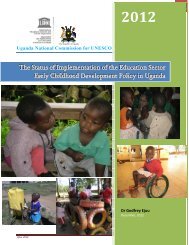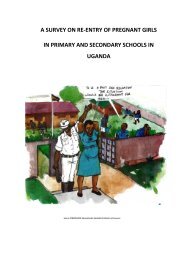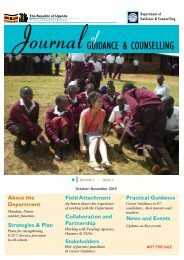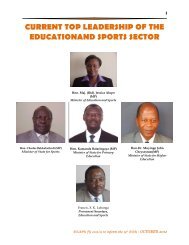Download Pdf - Ministry of Education and Sports
Download Pdf - Ministry of Education and Sports
Download Pdf - Ministry of Education and Sports
Create successful ePaper yourself
Turn your PDF publications into a flip-book with our unique Google optimized e-Paper software.
UBOS No target<br />
Annex A: Sector Performance against JAF IV Targets<br />
Impact Source <strong>of</strong> JAF 3 (2010/11) JAF 4 (2011/12) Explanatory Notes<br />
Verification Target Performance Target Status Rating<br />
% <strong>of</strong> literate 1319 year olds<br />
Male: 87.56% No target<br />
Not Ug<strong>and</strong>a Bureau <strong>of</strong> Statistics conducts House hold surveys to track national<br />
compared to 2005/6<br />
86.9%<br />
revealed that 47.48 percent (male 49.45%; female 45.59%) <strong>of</strong> the population<br />
household survey 6 aged 1319 year was literate. This implies that for every 100 people selected<br />
Total: 87.25%<br />
between the aged 1319 years only 47 were literate (as <strong>of</strong> 2005/06). The<br />
in Ug<strong>and</strong>a Panel Survey<br />
made Female: made<br />
Rated literacy rates every after 5 years. Findings <strong>of</strong> 2005/06 Household survey<br />
2009/10 Household Survey results indicate improvement in literacy levels<br />
among the population aged 1319 years. On average, for every 100 people<br />
selected, 87 (male 88; female 87) were found literate.<br />
Headline Sector Results<br />
Increase in number <strong>of</strong> pupils reaching defined level <strong>of</strong> competence in Government aided schools, against reducing unit cost<br />
· Literacy pr<strong>of</strong>iciency<br />
P3 total<br />
P3 girls<br />
P6 total<br />
P6 girls<br />
· Numeracy pr<strong>of</strong>iciency<br />
P3 total<br />
P3 girls<br />
P6 total<br />
P6 girls<br />
Increase in primary pupils<br />
passing PLE with grades I<br />
III at pure UPE schools<br />
Survival to P7by sex<br />
National<br />
Assessment<br />
<strong>of</strong> Progress<br />
in <strong>Education</strong><br />
2012 Report<br />
National<br />
Assessment<br />
<strong>of</strong> Progress<br />
in <strong>Education</strong><br />
2012 Report<br />
UNEBPLE<br />
Results 2011<br />
Preliminary<br />
Report<br />
EMIS 2012<br />
literacy<br />
P3 T: 60%<br />
P3 G: 60%<br />
P6 T: 55%<br />
P6 G: 55%<br />
numeracy<br />
P3 T: 72%<br />
P3 G: 72%<br />
P6 T: 55%<br />
P6 G: 49%<br />
Total<br />
280.000<br />
% girls 47<br />
Total: 34%<br />
Boys: 34%<br />
Girls: 34%<br />
literacy<br />
P3 T: 57.6%<br />
P3 G: 57.3%<br />
P6 T: 50.2%<br />
P6 G: 50.7%<br />
numeracy<br />
P3 T: 72.8%<br />
P3 G: 72%<br />
P6 T: 55%<br />
P6 G: 52.1%<br />
Total<br />
316,483<br />
% girls 48<br />
31%<br />
31%<br />
30.3%<br />
literacy<br />
P3 T: 60%<br />
P3 G: 60%<br />
P6 T: 52%<br />
P6 G: 52%<br />
numeracy<br />
P3 T: 73%<br />
P3 G: 73%<br />
P6 T: 56%<br />
P6 G: 50%<br />
Total<br />
320.000<br />
% girls 49<br />
Total:<br />
35%<br />
Boys: 35%<br />
Girls:<br />
35%<br />
literacy<br />
P3 T: 47.9%<br />
P3 G: 48.5%<br />
P6 T: 41.3%<br />
P6 G: 40.6%<br />
numeracy<br />
P3 T: 63%<br />
P3 G: 61%<br />
P6 T: 45.6%<br />
P6 G: 41.7%<br />
Total<br />
317,353<br />
% girls 48.1<br />
Total:32%<br />
Boys: 31%<br />
Girls: 32%<br />
Not<br />
Met<br />
Not<br />
Met<br />
Not<br />
met<br />
Not<br />
met<br />
156<br />
i) UNEB conducted a national assessment (NAPE) <strong>of</strong> literacy <strong>and</strong><br />
numeracy in a sample <strong>of</strong> 1,232 primary schools drawn from the<br />
112 districts <strong>of</strong> the country. The assessment was targeted at P.3<br />
<strong>and</strong> P.6 pupils.<br />
ii) The NAPE assessment results indicate that there was a signifiant<br />
decline in the percentage <strong>of</strong> pupils rated pr<strong>of</strong>icient in Literacy<br />
<strong>and</strong> Numeracy in the target P.3 <strong>and</strong> P.6 grades.<br />
iii) This decline is attributed to;<br />
· High rate <strong>of</strong> absenteeism among teachers that resulted into<br />
time loss <strong>and</strong> noncompletion <strong>of</strong> the syllabus.<br />
· Budgetary constraints making the Sector un able to supply<br />
all the necessary instructional materials to support the<br />
teaching <strong>and</strong> learning process<br />
· The type <strong>of</strong> tool used as well as the sample framework could<br />
have influenced the performance levels as well. The sector<br />
will constitute a team to establish other related factors that<br />
could have caused the decline for immediate address net FY.<br />
iv) ESCC has adapted concrete strategies to stem the declining<br />
trends<br />
Although there was improvement in the number <strong>of</strong> c<strong>and</strong>idates scoring<br />
division I to III improved from 316,483 (JAF III) to 317,353 (JAF IV), as well as<br />
in the proportion <strong>of</strong> females scoring division IIII, which increased by 0.1%age<br />
point from 48% to 48.1%, the set target was not met.<br />
A total <strong>of</strong> 558,155 (male 286,729; female 271,426) enrolled in Primary seven at<br />
the beginning <strong>of</strong> 2012. In 2006, a total <strong>of</strong> 1,763,284 (Male 883,827; female<br />
879,457) enrolled in P.1. This translates into a survival rate to P.7 <strong>of</strong> 32%.<br />
However, it is important to note that Survival to P.7 is cohort based therefore,<br />
there was need for the JAF IV targets to put into consideration the number <strong>of</strong><br />
6 The field work for the Ug<strong>and</strong>a Panel Survey was scheduled to start in October 2009. The baseline results will be available in October 2012<br />
ESSAPR FY 2011/12 to inform the 19 th ESSR – OCTOBER 2012








